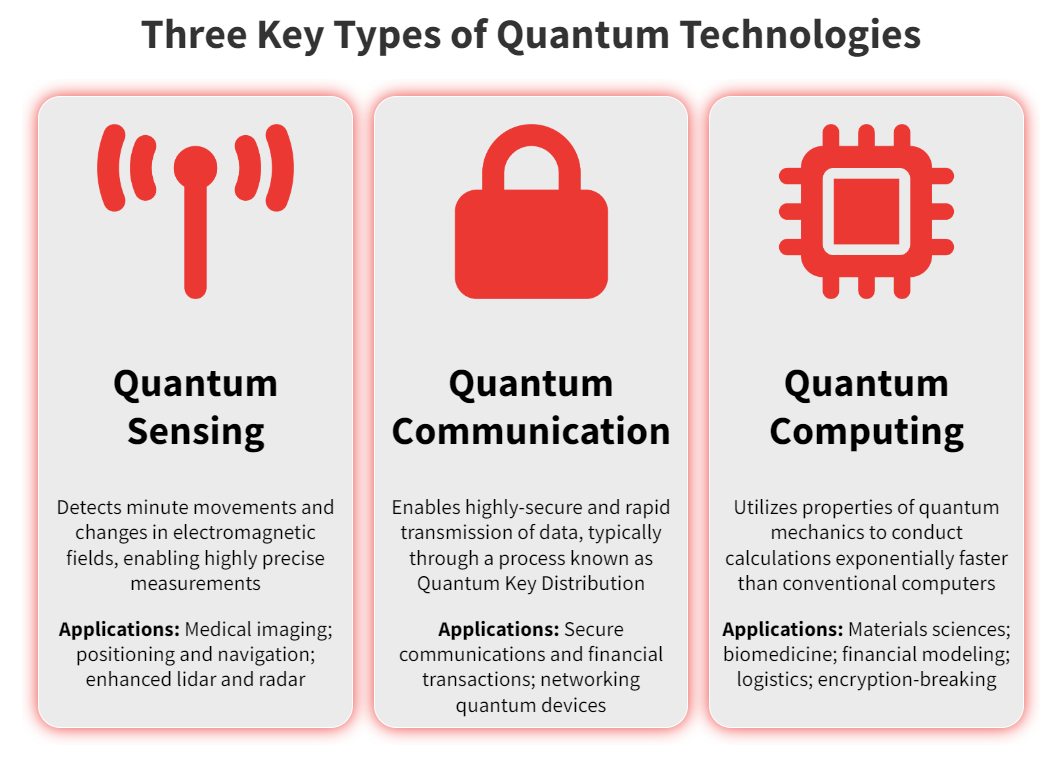
Introduction:
Intro 1:
Quantum technology is a rapidly developing field that harnesses the bizarre rules of quantum mechanics, the physics of the ultra-small, to create new and innovative ways to process information, sense the world, and even develop new materials

Intro 2:
An emerging field powered by the principles defined by quantum mechanics, a subfield of physics that explains the nature and behaviour of matter and energy on the atomic and subatomic level.

Intro 3:
Quantum technology is an exciting and rapidly advancing field that harnesses the principles of quantum mechanics—the physics governing subatomic particles.

Significance of Quantum Technology for India:
1. Staying Ahead of Others
2. Tackling National Security Threats
3. Boosting Translational Research
4. Fostering Economic Growth
5. Improving Quality of Life and Societal Progress
6. Encouraging Entrepreneurship
7. Quicken Adoption of 4th Industrial Revolution – IoT
8. Prediction – Weather and Earthquake
9. Epidemiological Research and Pharmacogenomics
Challenges:
1. Weak R&D Ecosystem
2. Lack of Skilled Professionals
3. Absence of Indigenous Development of Components
4. Industry Academia Gap
5. Technological Challenges
a. Maintain Low Temperature to reduce errors
b. Difficulty in upscaling number of qubits
c. Upscaling No of Qubits
6. Other Issues
a. Less Patent Applications
b. Lack of Regulation and Protocols
c. Global Governance
d. Low International Collaboration
India’s Initiatives:
1. National Quantum Mission – Rs. 6000 Cr Investments
2. National Mission Quantum Technologies & Applications (NMQTA)
3. Quantum Enabled Science and Technology (QuEST) Initiative
4. QSim – Quantum Computer Simulator Toolkit
5. Quantum Frontier Mission
6. Dedicated Labs and Centres:
a. Mhow, MP
Way Forward:
1. Creation of Dedicated Quantum Community
a. Entrepreneurship
b. Innovation
c. University Courses
d. Scholarships
e. Training Programmes
2. Dedicated R&D Centres
3. Facilitating International Cooperation
4. Safeguard National Security in Post Quantum Cryptography
5. Promoting Domestic Manufacturing Facilities
6. Revisit and Rework National Policies – Military Doctrines & Ethical Guidelines etc.
Conclusion:
Further steps like collaboration with the private sector, increased funding towards research, involvement of scientists and other stakeholders at the strategic level can propel India towards quickly harnessing the technology for its advantage as China and USA have been doing
National Quantum Mission:

Intro:
Launched in April 2023, the National Quantum Mission (NQM) is an ambitious program by the Indian government to develop quantum technologies and make India a leader in this revolutionary field

Conclusion:
National Quantum Mission is a giant stride in the future. To realise its potential, a collaboration between businesses, universities, and government must happen. This will help address the financial and human resource gaps and at the same time, aid in the creation of a national quantum research ecosystem
Quantum Key Distribution
Definition:
• QKD is a secure communication technology that uses quantum physics to construct a cryptographic protocol.
• It allows two parties to generate a shared secret key that can be used to encrypt and decrypt messages
• In traditional cryptography, security is usually based on the fact that an adversary is unable to solve a certain mathematical problem while in QKD, security is achieved through laws of quantum physics.
Quantum Communication:
• Quantum Communication refers to communication channels that leverage laws of quantum physics to protect data and make it more secure than traditional transmission
• In traditional key-based cryptography, data and keys are sent as classical bits (representing 1 and 0) as a stream of electrical or optical pulses.
• However, in a quantum communication network, data is transmitted via qubits
Quantum Coherence
• It is the ability of a quantum state to maintain its entanglement and superposition in the face of interactions.
• It deals with the idea that all objects have wave-like properties.
• If an object’s wave-like nature split in two, then two waves may coherently interfere with each other in such a way to form a single state that is a superposition of 2 states.

Quantum Dots:
• Quantum dots (QDs) are a unique type of nanocrystalline semiconductor whose electronic and optical properties are dependent on the size and shape of the dots.
• For spins in quantum dots, short coherence times were the biggest roadblock to applications in quantum technology.
Author: Arjun Kr. Paul, Faculty
Comments (0)
Categories
Recent posts


Q5/ Section B, APSC Mains 2024 Essay - ...
29 Jul 2024
Satellite Town
21 Jul 2024
Q 1/Section A, APSC Mains 2024 Essay - ...
29 Jul 2024



